Project Description
Why does America’s founding story always start with the Pilgrims in Plymouth Massachusetts? Jamestown colony started thirteen years before Plymouth; the first Virginia General Assembly was held in 1619, a year before the Pilgrims landed. Why aren’t America’s “baby pictures” of Jamestown instead of Plymouth?
Before we go to Plymouth Plantation, I think it would be wise to look at Jamestown and the other settlement attempts that came before it. In my opinion, it makes the Puritan expedition all that more amazing by comparison.
Roanoke Island
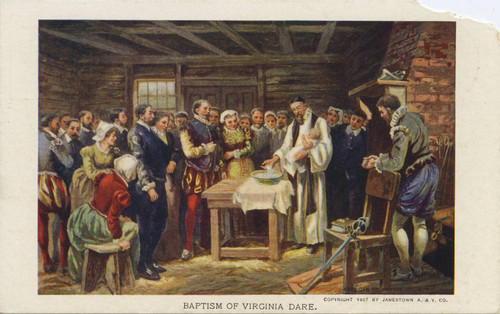
Baptism of Virginia Dare
The English colonization of America begins in 1585 when Sir Walter Raleigh was given a charter to explore and set up a permanent settlement in North America. He personally funded the endeavor and settlers landed on Roanoke Island in North Carolina. The first attempt failed due to conflicts with the native people and lack of food and supplies. A second attempt on the same island in 1587 lasted between 1 – 3 years. It was during this attempt that women and children accompanied the men, among them a pregnant woman and her husband. Her baby, named Virginia Dare, is considered to be the first European baby born and baptized in America. The settlers deposited on the island completely disappeared sometime within the first three years of existence. Today it is still referred to as “the Lost Colony.” These colonization attempts were strictly for exploration; there was no evangelistic motive alluded to.
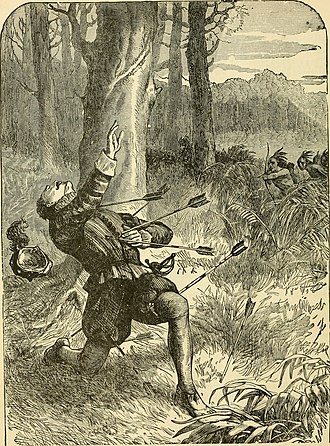
Death of George Howe at Roanoke
Twenty years later, England undertook another effort.
Jamestown
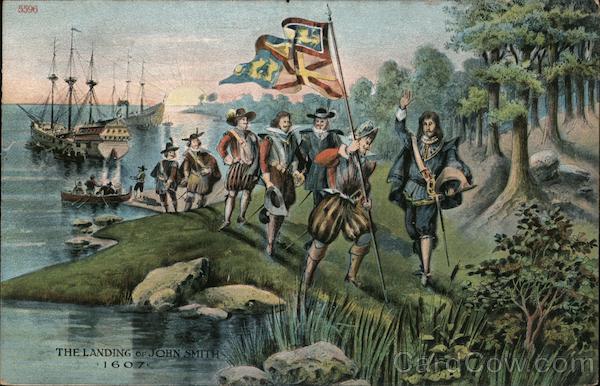
Landing at Jamestown
It’s now the winter of 1606 and three tiny ships prepare to sail down the Thames on route to the distant land of Virginia. Haley’s comet passes overhead, and it is regarded as a bad omen. On board the ships were approximately 105 passengers, all men, plus the crew members. The flagship, Susan Constant, was commanded by Captain Christopher Newport. The other two ships were smaller — the Godspeed and the Discovery. Among the 105 passengers were 59 “gentlemen” mostly younger men eager for adventure, but not for work. Fortunately there were others brought along for the practical needs of a new settlement. Among these were bricklayers, carpenters, a mason, a blacksmith, a barber and a tailor. Also included were a surgeon, a clergyman, some soldiers, a sailor and several small boys.
One of the reasons for this journey – if not the primary stated public justification – was to spread the gospel among the indigenous people of the New World. However, you can see from the passenger list that there was only one minister among them. His name was Robert Hunt, and when the voyage got off to a rough start in England and their departure was delayed by bad weather, he was the glue that held them together. Despite being very ill himself, he encouraged the rest of the passengers to stick with it and not to abandon ship.
In the original charter granted by King James to the Virginia Company on April 10, 1606, the first motivation for colonizing the New World is to spread the Christian religion:
Wee, greately commending and graciously accepting of theire desires to the furtherance of soe noble a worke which may, by the providence of Almightie God, hereafter tende to the glorie of His Divine Maiestie in propogating of Christian religion to suche people as yet live in darkeness and miserable ignorance of the true knowledge and worshippe of God and may in tyme bring the infidels and salvages living in those parts to humane civilitie and to a settled and quiet governmente . . .
Quite frankly, the passenger list doesn’t support the professed mission and there were other, more compelling reasons to go.
First, it was the “Age of Exploration.” Columbus’s discovery of the New World over one hundred years before had opened up a European race to the vast resources available on the new continent. Fantastic stories of gold and riches across the ocean were circulating in England. Also, England’s forests were being exhausted for shipbuilding so replenishment from the New World would be helpful. England was also motivated by the need to establish a Protestant foothold in the New World to keep in check Catholic Spain’s rigorous expansion. Last but not least, the desire to evangelize the Native Americans in the Protestant faith also moved men to action.
The leaders of the Virginia Company were members of the Church of England and brought the dry, established religion with them to Jamestown. They Church of England was hardly a bulwark of Christian doctrine and zeal. It was infused with Catholic ritual and symbolism. It was corrupt and powerful. This is the church from which the Pilgrims and Puritans will flee. As a result, the lives of these earliest colonists lacked a strong Christian commitment. Unlike the Puritans who saw God and the Bible as their entire lives, the nominal Christians who went to Jamestown saw God and the Bible as a part of their lives, perhaps even a small part – more cultural than heart-felt. Their squabbling, pride, arrogance, and greediness did not match the Puritan ethic or experience and it did not reflect people of devout faith. They almost wrecked the settlement right from the start because they had no zeal for God in their personal lives and certainly had no concern for evangelizing the Indians.
Still, men leaving for the New World of Virginia had to take an oath acknowledging the supremacy of the King, and the lack of authority of the Pope, before they could set sail to Virginia. When they arrived on April 29, they erected a cross and gave thanks to God on a point of land they named Cape Henry in honor of the eldest son of King James.
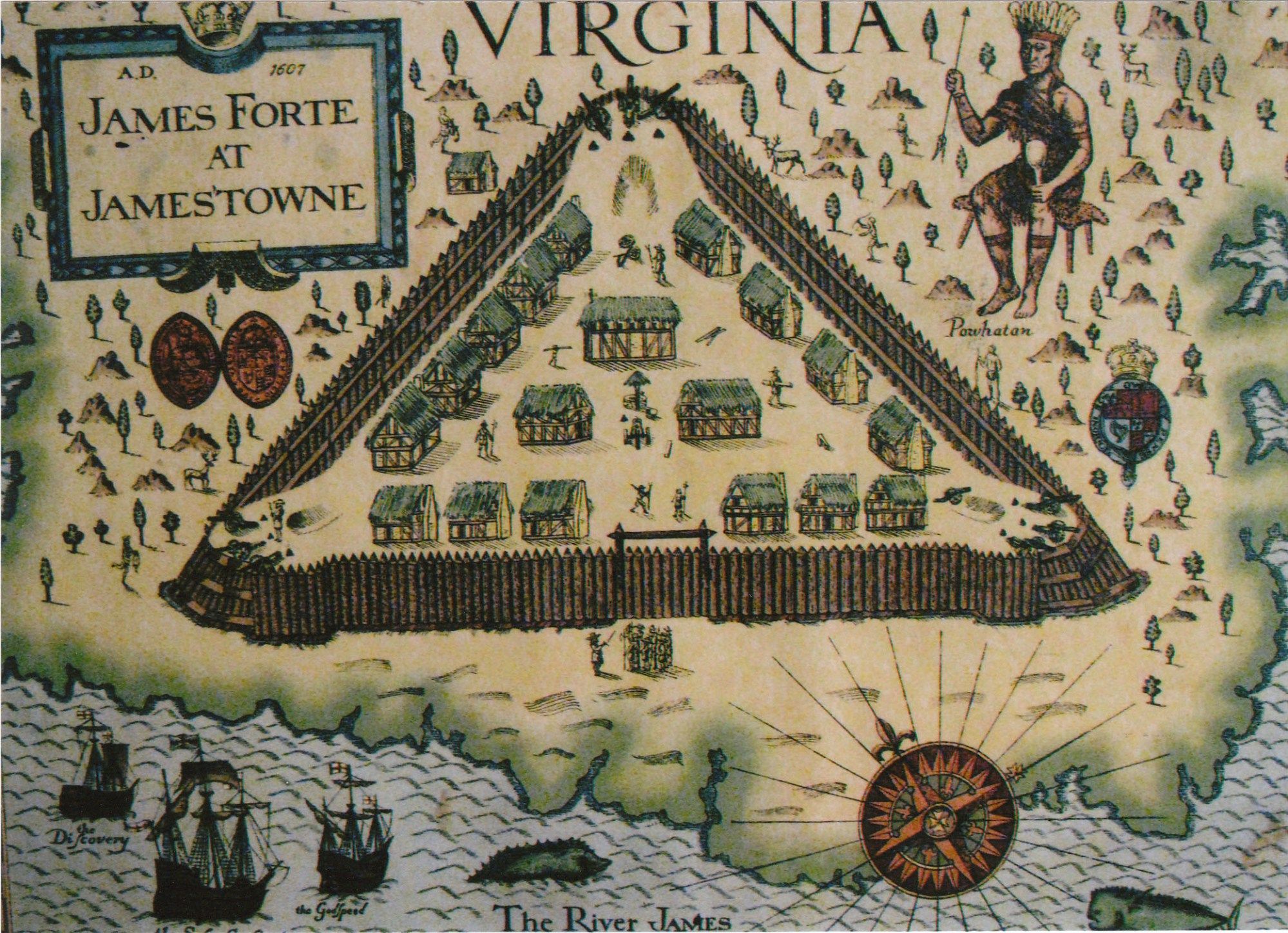
Early map of Jamestown
Captain John Smith says they erected a crude temporary structure to use for church services. Later that year, the settlers built the first real church building, a barn-like structure that was destroyed by fire in January 1608. The trappings of Christianity were there, and some, like Reverend Hunt, were devout, but overall, Jamestown was not a Christian mission; it was an opportunity to make money and do something for God.
The leaders of the colony were weak and combative. John Smith quickly rose among the leaders to be the best and brightest of them all. He replaced the failing socialistic system they had established with a new plan, inspired by 2 Thessalonians 3:10, “he that will not work shall not eat.” His efforts turned things around for the settlement temporarily.
It was May 24, 1607 when they established Jamestown. By the time autumn arrived later that year more than half of those who had come ashore were already in their graves. More settlers continued to flow into Jamestown and by the fall of 1609 they were approximately five hundred there. However, the winter of 1609-10 was the coldest and deadliest ever at the settlement, and by the spring of 1610, only 60 were still alive.
By the time Lord de la Warr arrived in 1610, the settlement was such a chaotic disaster, and so far removed from its Christian mission that he established martial law in order to enforce discipline among the men who were in open conflict with the natives. Under the military rule, church attendance was mandatory again. Services were held fourteen times a week, with sermons preached twice on Sunday and once on either Wednesday or Thursday. Two prayer services, one in the morning and one in the evening, were held Monday through Saturday. These services followed the Book of Common Prayer. One of the Sunday services was followed by the reading of the laws, so that everyone was made aware of the rules.
The story of Jamestown is a story of small peaks and deep valleys, periods of planting and harvesting, and periods of sickness, starvation, and dying. Those who are critical of Columbus because he brought disease to the indigenous people need only to look at Jamestown and the two failed settlements prior to it to see that the danger was equally shared by the Europeans and the natives. Typhoid, beriberi, dysentery, starvation, and Indian attack are just some of the dangers that awaited the settlers.
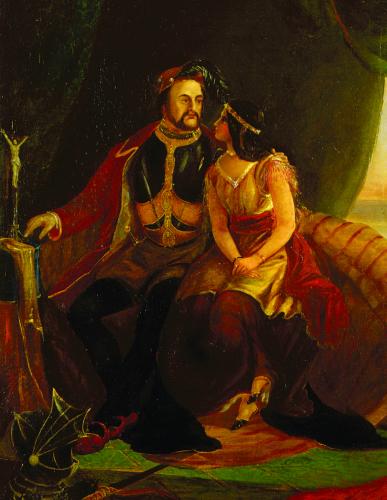
John Rolfe and Pocahontas
One couple’s story stands out in the Christian history of Jamestown, and that is of course, John Rolfe and Pocahontas. Unlike the earliest settlers, Rolfe was a hardworking man whose Christian faith was very important to him. Calvin’s Institutes was one of the works he had carefully studied. He believed there was a Christian purpose for Jamestown, and he sought to “advance the Honor of God, and to propagate his Gospel.” He believed there was “no small hope by piety, clemency, courtesy and civil demeanor to convert and bring to the knowledge and true worship of Jesus Christ to thousands of poor wretched and misbelieving people: on whose faces a good Christian cannot look, without sorrow, pity and commiseration; seeing they bear the Image of our heavenly Creator, and we and they come from one and the same mold. . .”
Rolfe’s heart was stolen by Pocahontas, daughter of the Indian chief Powhatan. Rolfe loved the young woman but was unsure whether marriage with her would be in God’s will. He wrestled with himself — wondering if marrying a heathen woman wouldn’t be like the Israelites of old marrying the Canaanites, something the Lord had definitely forbidden. He finally thought that as a laborer in the Lord’s vineyard, he should plant the seed of the gospel so she could become a Christian. With her conversion, Pocahontas took the Christian name of Rebecca, and she became John Rolfe’s wife. Their marriage brought a temporary peace between the English colonists and the Indians. This momentous event is captured in this painting which hangs in the nation’s capital as a testimony to the spread of the Christian faith in North America.[1]
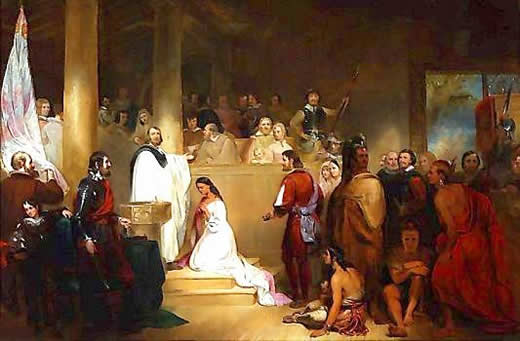
Baptism of Pocahontas
If we compare the nominal Christianity of Jamestown to the zealous Christianity of Plymouth Plantation we will see the difference a passionate, practicing Christian community makes compared to lukewarm establishment Christians. The reason we acknowledge Jamestown and honor Plymouth is due in large part to the Christian influence Plymouth had on our nation in the years that would follow. Jamestown was a settlement; Plymouth was a seed.
[1] https://www.christianity.com/church/church-history/timeline/1601-1700/christianity-in-jamestown-11630060.html
